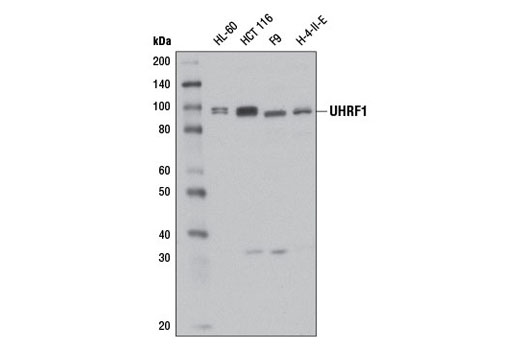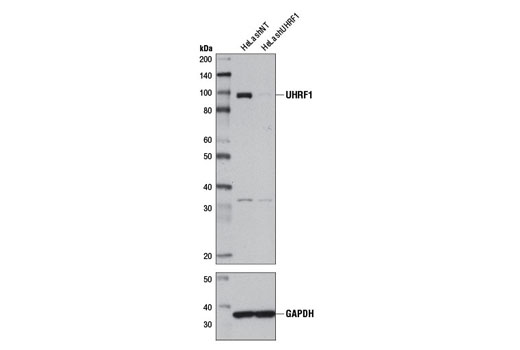WB, IP
H M R
Endogenous
95
Rabbit IgG
#Q96T88
29128
Product Information
Product Usage Information
| Application | Dilution |
|---|---|
| Western Blotting | 1:1000 |
| Immunoprecipitation | 1:50 |
Storage
Specificity / Sensitivity
Species Reactivity:
Human, Mouse, Rat
Source / Purification
Monoclonal antibody is produced by immunizing animals with a synthetic peptide corresponding to residues surrounding Val78 of human UHF1 protein.
Background
Ubiquitin-like PHD and RING finger domain-containing protein 1 (UHRF1), also known as Inverted CCAAT box-binding protein of 90 kDa (ICBP90) and Nuclear Zinc Finger Protein NP95 (NP95), is a nuclear protein that was first discovered as a CCAAT box-binding protein that regulates the expression of the Topoisomerase IIα (TOP2A) and Rb1 genes (1,2). Later studies have shown that UHRF1 is required for maintenance of CpG DNA methylation, the process of copying pre-existing methylation patterns onto the newly synthesized DNA strand after DNA replication (3-5). UHRF1 localizes primarily with highly methylated pericentromeric heterochromatin and is required for proper structure and function of these regions of the genome (6,7). However, UHRF1 also localizes to euchromatic regions of the genome and functions to negatively regulate the expression of a subset of tumor suppressor genes (2,8,9). The localization and repressive functions of UHRF1 are both mediated by several protein domains, including a ubiquitin-like (UBL) domain, Tudor domain, PHD domain, SET and RING finger-associated (SRA) domain, and a RING finger domain. The SRA domain of UHRF1 binds with high affinity to hemi-methylated DNA and functions to properly target the associated maintenance DNA methyltransferase DNMT1 protein to mediate faithful methylation of the newly synthesized DNA strand (3-5). Additional targeting of UHRF1 to heterochromatin is mediated by the Tudor domain, which binds specifically to tri-methylated Lys9 of histone H3, a histone mark associated with pericentromeric heterochromatin (10-12). Targeting of UHRF1 to euchromatin is further mediated by the PHD domain, which binds specifically to unmethylated Arg2 of histone H3, which is commonly associated with euchromatin (13). In addition to recruiting DNMT1, UHRF1 recruits the histone deacetylase 1 (HDAC1) protein to target loci, resulting in deacetylation of histones, and providing an additional mechanism for transcriptional repression (3). Taken together, these studies demonstrate that UHRF1 functions to link DNA methylation and histone modifications to the maintenance of repressive chromatin structures. These functions of UHRF1 are important for proper maintenance of cell growth and proliferation, as research studies have shown UHRF1 overexpression in a number of cancers (breast, lung, colon, and prostate cancer) is associated with increased proliferation and malignancy (9,14-16).
- Hopfner, R. et al. (2000) Cancer Res 60, 121-8.
- Jeanblanc, M. et al. (2005) Oncogene 24, 7337-45.
- Unoki, M. et al. (2004) Oncogene 23, 7601-10.
- Sharif, J. et al. (2007) Nature 450, 908-12.
- Bostick, M. et al. (2007) Science 317, 1760-4.
- Papait, R. et al. (2007) Mol Biol Cell 18, 1098-106.
- Papait, R. et al. (2008) Mol Biol Cell 19, 3554-63.
- Daskalos, A. et al. (2011) Cancer 117, 1027-37.
- Kim, J.K. et al. (2009) Nucleic Acids Res 37, 493-505.
- Nady, N. et al. (2011) J Biol Chem 286, 24300-11.
- Liu, X. et al. (2013) Nat Commun 4, 1563.
- Rothbart, S.B. et al. (2012) Nat Struct Mol Biol 19, 1155-60.
- Rajakumara, E. et al. (2011) Mol Cell 43, 275-84.
- Babbio, F. et al. (2012) Oncogene 31, 4878-87.
- Kofunato, Y. et al. (2012) Oncol Rep 28, 1997-2002.
- Unoki, M. et al. (2010) Br J Cancer 103, 217-22.
Species Reactivity
Species reactivity is determined by testing in at least one approved application (e.g., western blot).
Western Blot Buffer
IMPORTANT: For western blots, incubate membrane with diluted primary antibody in 5% w/v BSA, 1X TBS, 0.1% Tween® 20 at 4°C with gentle shaking, overnight.
Applications Key
WB: Western Blotting IP: Immunoprecipitation
Cross-Reactivity Key
H: human M: mouse R: rat Hm: hamster Mk: monkey Vir: virus Mi: mink C: chicken Dm: D. melanogaster X: Xenopus Z: zebrafish B: bovine Dg: dog Pg: pig Sc: S. cerevisiae Ce: C. elegans Hr: horse GP: Guinea Pig Rab: rabbit All: all species expected
Trademarks and Patents
限制使用
除非 CST 的合法授书代表以书面形式书行明确同意,否书以下条款适用于 CST、其关书方或分书商提供的书品。 任何书充本条款或与本条款不同的客书条款和条件,除非书 CST 的合法授书代表以书面形式书独接受, 否书均被拒书,并且无效。
专品专有“专供研究使用”的专专或专似的专专声明, 且未专得美国食品和专品管理局或其他外国或国内专管机专专专任何用途的批准、准专或专可。客专不得将任何专品用于任何专断或治专目的, 或以任何不符合专专声明的方式使用专品。CST 专售或专可的专品提供专作专最专用专的客专,且专用于研专用途。将专品用于专断、专防或治专目的, 或专专售(专独或作专专成)或其他商专目的而专专专品,均需要 CST 的专独专可。客专:(a) 不得专独或与其他材料专合向任何第三方出售、专可、 出借、捐专或以其他方式专专或提供任何专品,或使用专品制造任何商专专品,(b) 不得复制、修改、逆向工程、反专专、 反专专专品或以其他方式专专专专专品的基专专专或技专,或使用专品开专任何与 CST 的专品或服专专争的专品或服专, (c) 不得更改或专除专品上的任何商专、商品名称、徽专、专利或版专声明或专专,(d) 只能根据 CST 的专品专售条款和任何适用文档使用专品, (e) 专遵守客专与专品一起使用的任何第三方专品或服专的任何专可、服专条款或专似专专


